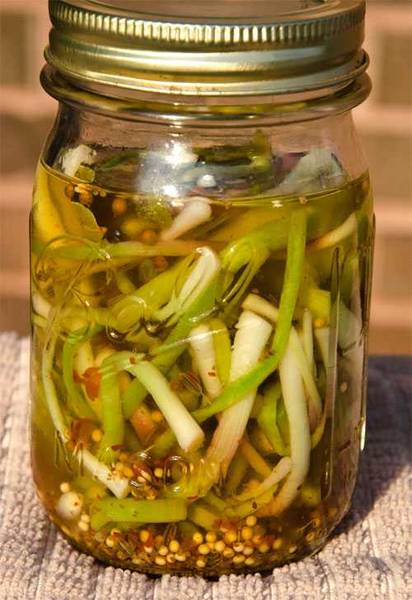Ramps are a wild onion found in clumps in Northeastern woods all the way to Canada. The are in season only in the spring. But they are similar to scallions and green onions and this recipe works fine on them. In fact it works on any onions!
According to historians, the river that ran by the native American village near the mouth of the giant lake was lined with wild onions, most likely ramps or wild leeks. In the The Encyclopedia of Chicago, Ann Durkin Keating says “The name ‘Chicago’ derives from a word in the language spoken by the Miami and Illinois peoples meaning ‘striped skunk,’ a word they also applied to the wild leek (known to later botanists as Allium tricoccum). This became the Indian name for the Chicago River, in recognition of the presence of wild leeks in the watershed. When early French explorers began adopting the word, with a variety of spellings, in the late seventeenth century, it came to refer to the site at the mouth of the Chicago River.”
Ramps are like other onions, an underground bulb and long tall green grasslike stalks. Ramps are much smaller than leeks, more like scallions, but the leaves are flatter. They are most tender and tasty in spring, and as with robins, when they arrive I know spring is really here. Onion stalks are the first thing edible to push up in spring, and a chomp on raw ramps is my first celebratory rite of spring.
Ramps propagate rapidly and a handful planted in spring will produce a bucketful by late summer. Like scallions, served raw, they add a pungent bite to salads, and can be stir fried or grilled as a side dish or topping for meats.
When pickled, they are sweet, sour, tangy, and a great relish to accompany BBQ and grilled foods. Add them to coleslaw. Top a burger or pulled pork sandwich. Or any sandwich for that matter. Toss into a salad or into grilled veggies.
I fell for the pickled ramps by Chef Rick Gresh as a side dish. I asked for his permission to publish his recipe and he gave me the go-ahead with the request that I disclose that his recipe is based on one by eminent Chef Tom Colichio. With his permission, here’s Chef Gresh’s recipe for pickled ramps, slightly modified by Yours Truly. Try them on a pulled pork sammie or on hot dogs. Please note, these are refrigerator pickles, which means they must be kept chilled.
Up your game: Join our Pitmaster Club. Try it out for free for 30 days. No credit card is needed. No spam. Join now and Be Amazing!
Makes:
Takes:
Ingredients
- 1 pound ramps, including leaves
- ¾ cup water
- ½ cup white wine vinegar or distilled vinegar
- ¼ cup granulated sugar
- 1 tablespoon honey
- ½ teaspoon whole mustard seeds
- ½ teaspoon whole coriander seeds
- ½ teaspoon whole fennel seed
- ½ teaspoon whole celery seeds
- ½ teaspoon red pepper flakes
- 1 whole bay leaf
- ½ teaspoon Morton Coarse Kosher Salt
These recipes were created in US Customary measurements and the conversion to metric is being done by calculations. They should be accurate, but it is possible there could be an error. If you find one, please let us know in the comments at the bottom of the page
Method
- Clean the ramps, removing the large green leaves. You can use them in a vegetable dish, or wilt them in a pan and serve them as a topping on meats or other dishes. They’re good on pizza or chopped into rice and couscous.
- Combine everything except the ramps and bring to a boil. Keep the liquid in the hot pan and let it cool for about 30 minutes. Refrigerate.
- Boil a pot of water and drop the ramps in for about 20 seconds. This is called blanching and it alters the chemistry of the bulbs, and pastuerizes them. Quickly drain the pot into a colander and run cold water over the ramps for about a minute to shock them and rapidly stop the cooking.
- Put the ramps in a very clean jar and cover them with the cool pickling liquid. Refrigerate for 5 days before using, and keep refrigerated for months.



High quality websites are expensive to run. If you help us, we’ll pay you back bigtime with an ad-free experience and a lot of freebies!
Millions come to AmazingRibs.com every month for high quality tested recipes, tips on technique, science, mythbusting, product reviews, and inspiration. But it is expensive to run a website with more than 2,000 pages and we don’t have a big corporate partner to subsidize us.
Our most important source of sustenance is people who join our Pitmaster Club. But please don’t think of it as a donation. Members get MANY great benefits. We block all third-party ads, we give members free ebooks, magazines, interviews, webinars, more recipes, a monthly sweepstakes with prizes worth up to $2,000, discounts on products, and best of all a community of like-minded cooks free of flame wars. Click below to see all the benefits, take a free 30 day trial, and help keep this site alive.
Post comments and questions below
1) Please try the search box at the top of every page before you ask for help.
2) Try to post your question to the appropriate page.
3) Tell us everything we need to know to help such as the type of cooker and thermometer. Dial thermometers are often off by as much as 50°F so if you are not using a good digital thermometer we probably can’t help you with time and temp questions. Please read this article about thermometers.
4) If you are a member of the Pitmaster Club, your comments login is probably different.
5) Posts with links in them may not appear immediately.
Moderators